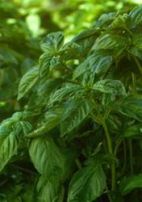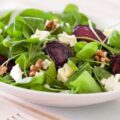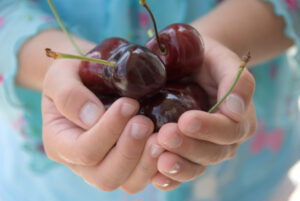Cooking with herbs – Lynley Ruck
“I believe that if ever I had to practice cannibalism, I might manage if there were enough tarragon around.”- James Beard, American Chef and Author
James Beard, American Chef and Author
Leave your tastebuds in no doubt that Spring has arrived with the fresh, delicate flavours and fragrances of spring sprouting home-grown herbs. Herbs such as dill, mint, or parsley, can instantly put an end to the monotony of wintery starchy comfort cooking. In Tudor times a salad bowl would have had at least thirty different herb leaves and flowers mixed in the bowl. By mixing a few of each type of herb leaf that can be eaten raw, a gourmet salad is easily created – look no further than your own windowsill.
Herbs, that is the green leaves, stems or flowers of certain fragrant plants, are vital items in any cook’s toolkit. Fresh herbs boost flavour and nutrition – without adding extra fat, calories, or sodium and what better way to beat the budget than to grow your own. There is such satisfaction to be had harvesting your own herbs on demand, and many are perennials and/or self-seeders. If there are a few fresh herbs in your kitchen garden, there is always a meal at hand… just add pasta, garlic and extra virgin olive oil.
The cultivation and use of wild and domesticated herbs is well documented. Old tales of physicians and sorcerers, wise women and traders, of trans-continental spice routes being forged and songs, plays and poems have been passed down through generations. Whether we grow herbs, eat them or take them as medicine, they carry us, if we stop to think about them, far back into history.
I adore the assault on my senses when wandering through the garden and brushing past the Babylonian herbal overhang, herbs have such lush green leaves and pretty flowers that introduce fragrance to the garden as well as embellishing your food.
Whether you grow your herbs in a stately geometric potager with clipped hedges, in pots on balconies, as hedging or adopt what I call jungle effect gardening, make sure you grow what you enjoy eating. If you love Asian flavours, grow Thai basil, kaffir limes, lemongrass and coriander, if Italian is your thing then you will want flat leaf parsley, rosemary, oregano and thyme in your patch.
My favourite short-term way to keep fresh herbs is an Elizabeth David method, to make them up “immediately” into herb butters or oils, stored in plastic containers to flavour egg dishes, or grilled fish or meats. When life hands you basil – make pesto – it freezes really well or, just trim the stems and place in a jar of water; cover the tops with a plastic bag or wrap, and refrigerate. Herbs will keep for at least a week like this, often longer. Fresh basil leaves can also be frozen fresh in plastic bags for up to six months. Herbs such as mint, tarragon, basil, thyme, rosemary and oregano (but not parsley, chives or fennel) can be dried, on the stalk if possible, slowly in paper bags in a dark dry space and then kept in jars for later use. Use the stalks later, underneath roasting meat or as skewers for kebabs on the barbeque.
Always add fresh herbs at the end of cooking for maximum flavour. Dried herbs have more intense flavour compared to fresh, and should be used more cautiously. Replace dried herbs every year – packets of tasteless dust in cardboard boxes will not do your cooking any favours.
There are squillions of online sources packed full of the knowledge required to successfully grow herbs for your kitchen. My favourite purveyor of herb and vegetable seeds can be found here: Grab a pot or a plot, some compost and get growing – it’s easy, and the benefits are manifold.
BASIL
No herb quite speaks more to me of summer than Basil. Basil is a companion to olive oil and tomatoes; it is true, but oh so very much more. Try Basil in salad dressing, torn into mayonnaise, as a leaf in green salads and of course in the ubiquitous Genoese basil pesto. The french version of pesto is pistou – try the delightful French spring Soupe au pistou where basil is the star of the show. Basil often features in tomato sauce and tomato soup, alongside oven roasted tomatoes, in herb breads or even curiously with fruit salad. Try this simple baked brown rice risotto, easy, nutritious and delicious.
CHERVIL
Chervil is very similar to parsley, but is sweeter and delicately scented with aniseed, it is gorgeous in mashed potatoes or scrambled eggs, is lovely chopped and roasted with vegetables such as fennel, eggplant and courgettes. Chervil is an essential component of fines herbs (parsley, chives, tarragon and chervil) a subtle combination of delicate herbs and also the more robust bouquet garnis (which usually includes parsley thyme and a bay leaf, and may also include basil, thyme, chervil, rosemary, peppercorns, savoury and tarragon) being the quintessential bundle of various herbs utilised in long slow French recipes. Chervil is great in roasted beetroot salads, chopped into mayonnaise or omelettes, in béarnaise sauce with tarragon, in spring vegetable soups, in stuffing for poultry or lamb and in herb apple jelly as an accompaniment to roasted meats.
CHIVES
These lovely oniony grass-like tubes are planted at intervals throughout my vegetable garden. Use the flowers in your salad, use whole chives as interesting garnishes, tie them into bows or form them into circles or triangles, securing the shape by sticking the tip into a cut end. Try using them to tie bundles of vegetable strips. If the chives are too stiff to manipulate, blanch them for ten seconds in boiling water. Use in all salads and salad dressings, herb butters, omelettes, curried eggs and the creamy chilled Vichyssoise Soup. Chives will go in tomato sauce, any white sauce, fish pie, snipped into new potatoes, in hash browns, potato salads, in fact anywhere where you would use onions or spring onions, always add towards the end of cooking for maximum flavour. Chives are great with seafood.
CORIANDER
You either love or hate coriander, it’s lemon style pungency sends some into a swoon, others describe it as tasting like soap. I think you may be able to tell on which side of the fence I sit. Indispensible as an ingredient in dishes such as ceviche (raw fish salad) or a fresh fruit salsa, coriander goes really well with barbeques prawns and asian style soups and in particular the pungent hot sour spicy flavours of Thai cuisine. Ceviche is fish cooked in the citric acid in lime and other juices, it’s zippy flavour and succulent texture has made it a favourite from Peru and Ecuador across the entire Pacific to the Islands, I have included the recipe given to me by a Fijian friend for Kokoda, the Fijian version. Use coriander with prawns, tofu, Asian dishes, fish, coriander pesto, and Thai pork balls. Coriander grows well during the colder months, it will go to seed easily during the summer.
Growing tip – often people have problems with coriander going to see prematurely. Coriander dislikes root disturbance so seedlings can often go to seed soon after planting. Try growing it from seed direct in the garden and letting it to grow where it lands.
DANDELION
Often totally disregarded and mistreated, the humble dandelion is making a resurgence on the culinary scene, in the States you can buy bunches of organic, tender young dandelion leaves, I sense a gap in the New Zealand market! The greens can be bitter so use very young sprayfree leaves. Italian Dandelion Salad is very good. Long touted for it’s curative effect on the liver, Dandelion tea is a great general pick-me-up – 1 tsp per cup boiling water, steep 5-10 mins strain – supposedly also good for the gall bladder, rheumatism, as a digestive, diuretic or tonic.
DILL
Dill marries perfectly with seafood, try this lovely salmon recipe. Dill and pickles have traditional been paired, try slicing cucumber and serving with a dill vinaigrette. Chop and rub dill on chicken and put lemons in the cavity of a roasted chicken, add to mayonnaise especially with fish, or dill seeds in cream cheese, fish soups, dill seeds with lentil dishes, this fresh tartare dressing and of course in cucumber pickles. Never plant dill with fennel – they will cross germinate.
MINT
I never plant my mint in a container to stop it from taking over the garden, I would be delighted if it did, I love the fragrance so much. I use it as the je ne sais quois in my salads, Mint is imperative in tabouleh with parsley, in many Asian inspired dressings, a natural in potato salad, in mint sauce of course. You can also make syrups for drinks & jellies, fresh/frozen pea soup, iced tea, herb tea, with new peas and/or carrots, new potatoes, in fruit salad, sorbets, apple jelly, and as a floater in any refreshing summer drink or tea
NASTURTIUM
Baby Nasturtium leaves add a peppery component to salad greens, and the edible flowers look, well, good enough to eat, be adventurous I also add calendula flower petals, borage, viola and chive flowers into salads during the summer months. Mock capers can be made with the seed pods, but apparently just taste of spiced vinegar, why would you bother?
PARSLEY
One of the most common herbs to be found, easy to grow and totally indispensible, I wouldn’t be without Italian flat-leafed parsley in my garden. Use in marinades, as a leaf in green salads, in parsley pesto, parsley butter, dressings, (herb vinaigrette) or as a garnish or over, in and through anything Italian! Use in pates, omelettes and scrambled eggs, in gremolata, in stuffing, fry parsley in butter as a garnish for cooked fish or chicken, in savoury parmesan biscuits. As a herbal remedy, 1 tsp per cup boiling water, cover, steep 5-10 minutes, strain, serve hot or iced, as a tonic for haemorrhoids or rheumatism, is a diuretic and a tonic.
ROSEMARY
I once lived on Onetangi beach and our front hedge was rosemary – if it thrived in that sandy soil and seaspray then it will grow almost anywhere, surely. A Mediterranean staple that conjures skewered and roasted meat to my mind, it is great on focaccia bread, in bean soups and in soffritto (celery, onion, leek, carrot and parsley thyme and rosemary, sautéed in olive oil) – the base of many Italian and Spanish stews. A component of Herbs de provence (thyme, oregano, savory and sometimes lavender) Very useful in marinades, inserted into or under roasting lamb with slivers of garlic. Put Rosemary into crab apple jelly for serving with roasted or grilled meats. My favourite is oven baked potatoes with olive oil, seasalt, garlic and rosemary leaves. Always use sparingly as Rosemary is quite pungent and leathery – chop finely.
SAGE
Sage comes from salvare to be saved and means health. The Romans grew it wherever they travelled, and Italian cooks are expert at utilising sage in many ways. Sage leaves fried in butter or olive oil are a special way to garnish meat dishes and a simple risotto. Saltimbocca is a well known Italian dish skewering veal, prosciutto and sage. Sage goes very well with gamey meats and cheese. Use with Pork, in stuffing for chicken or chicken breasts, goose, turkey, roast venison, rabbit, sage jelly. It is well worth mentioning the glorious pineapple sage, with it’s fiery flowers, a wonderful addition to the garden and chopping leaves into salad is a fine thing to do.
THYME
I use thyme as the continuity factor around the borders of my garden, ornamental and culinary. A sun-loving and easy to grow herb, I continuously plant to replace old and woody specimens. I use thyme when roasting beetroot or asparagus in olive oil and lemon juice and zest, when roasting tomatoes or potatoes (try kumara also) or in potato salad. I use the lemon variety in the cavity of roasting chickens or under the skin of the breast or to flavour sweet custard (remove the leaves after flavouring the milk). There is pizza thyme for pizzas, garden thyme for tomato sauces, in minestrone, as a base note in vegetable soups, with lamb beef, pork casseroles and in herb breads. Add thyme to caramelised onions, mushrooms, savoury parmesan biscuits, it can even be added to apple puddings as a surprise guest.
Medicinally, you can use thyme as a mouth wash (for sore throats & gum problems)
4 cups water, 100 g dried thyme. Boil water and pour over thyme, strain and leave till cold. This will keep in fridge around 3 days. Gargle 3-4 times daily.





For more information about Dandelion Tea please go to http://www.dandeliontea.org. Thanks!